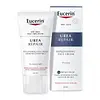What's inside
What's inside
 Key Ingredients
Key Ingredients

 Benefits
Benefits

 Concerns
Concerns

 Ingredients Side-by-side
Ingredients Side-by-side

Glycerin
HumectantDecyl Oleate
EmollientOctyldodecanol
EmollientRicinus Communis Seed Oil
MaskingButyrospermum Parkii Butter
Skin ConditioningC18-38 Alkyl Hydroxystearoyl Stearate
EmollientCaprylic/Capric Triglyceride
MaskingCetearyl Alcohol
EmollientDicaprylyl Carbonate
EmollientBis-Diglyceryl Polyacyladipate-2
EmollientHydrogenated Coco-Glycerides
EmollientCetyl Palmitate
EmollientPolyglyceryl-3 Diisostearate
EmulsifyingBeeswax
Emulsion StabilisingHydrogenated Castor Oil
EmollientUrea
BufferingGlycine
BufferingSodium PCA
HumectantArginine Hcl
Skin ConditioningSodium Ascorbyl Phosphate
AntioxidantTocopherol
AntioxidantHelianthus Annuus Seed Oil
EmollientWater
Skin ConditioningMagnesium Stearate
Cosmetic ColorantMagnesium Sulfate
Decylene Glycol
Skin ConditioningGlycerin, Decyl Oleate, Octyldodecanol, Ricinus Communis Seed Oil, Butyrospermum Parkii Butter, C18-38 Alkyl Hydroxystearoyl Stearate, Caprylic/Capric Triglyceride, Cetearyl Alcohol, Dicaprylyl Carbonate, Bis-Diglyceryl Polyacyladipate-2, Hydrogenated Coco-Glycerides, Cetyl Palmitate, Polyglyceryl-3 Diisostearate, Beeswax, Hydrogenated Castor Oil, Urea, Glycine, Sodium PCA, Arginine Hcl, Sodium Ascorbyl Phosphate, Tocopherol, Helianthus Annuus Seed Oil, Water, Magnesium Stearate, Magnesium Sulfate, Decylene Glycol
Water
Skin ConditioningGlycerin
HumectantUrea
BufferingCetyl Alcohol
EmollientCaprylic/Capric Triglyceride
MaskingPentaerythrityl Tetraisostearate
EmollientTriisostearin
Skin ConditioningSodium Lactate
BufferingGlyceryl Stearate
EmollientArginine Hcl
Skin ConditioningDimethicone
EmollientPotassium Cetyl Phosphate
EmulsifyingXanthan Gum
EmulsifyingBiosaccharide Gum-1
HumectantLactic Acid
Buffering1,2-Hexanediol
Skin ConditioningPhenoxyethanol
Preservative
 Reviews
Reviews

Ingredients Explained
These ingredients are found in both products.
Ingredients higher up in an ingredient list are typically present in a larger amount.
We don't have a description for Arginine Hcl yet.
This ingredient is an emollient, solvent, and texture enhancer. It is considered a skin-softener by helping the skin prevent moisture loss.
It helps thicken a product's formula and makes it easier to spread by dissolving clumping compounds.
Caprylic Triglyceride is made by combining glycerin with coconut oil, forming a clear liquid.
While there is an assumption Caprylic Triglyceride can clog pores due to it being derived from coconut oil, there is no research supporting this.
Learn more about Caprylic/Capric TriglycerideGlycerin is already naturally found in your skin. It helps moisturize and protect your skin.
A study from 2016 found glycerin to be more effective as a humectant than AHAs and hyaluronic acid.
As a humectant, it helps the skin stay hydrated by pulling moisture to your skin. The low molecular weight of glycerin allows it to pull moisture into the deeper layers of your skin.
Hydrated skin improves your skin barrier; Your skin barrier helps protect against irritants and bacteria.
Glycerin has also been found to have antimicrobial and antiviral properties. Due to these properties, glycerin is often used in wound and burn treatments.
In cosmetics, glycerin is usually derived from plants such as soybean or palm. However, it can also be sourced from animals, such as tallow or animal fat.
This ingredient is organic, colorless, odorless, and non-toxic.
Glycerin is the name for this ingredient in American English. British English uses Glycerol/Glycerine.
Learn more about GlycerinUrea is also called carbamide and is the diamide of carbonic acid. In cosmetics, urea is used to hydrate the skin. It also provides exfoliation in higher concentrations.
As a humectant, urea helps draw moisture from the air and from deep within the skin. This helps hydrate your skin. Studies show urea is an effective moisturizer for dry skin conditions. 40% urea is typical in medications for treating eczema and other skin conditions.
Urea has the strongest exfoliation effect in concentrations higher than 10%. It is a keratolytic agent, meaning it breaks down the keratin protein in the top layer of skin. This helps remove dead skin cells and flaking skin.
In medicine, urea has been shown to help increase the potency of other ingredients, such as fungal treatments.
Humans and animals use urea to metabolize nitrogen-containing compounds. Urea is highly soluble in water. Once dissolved, it is neither acidic nor alkaline.
Learn more about UreaWater. It's the most common cosmetic ingredient of all. You'll usually see it at the top of ingredient lists, meaning that it makes up the largest part of the product.
So why is it so popular? Water most often acts as a solvent - this means that it helps dissolve other ingredients into the formulation.
You'll also recognize water as that liquid we all need to stay alive. If you see this, drink a glass of water. Stay hydrated!
Learn more about Water